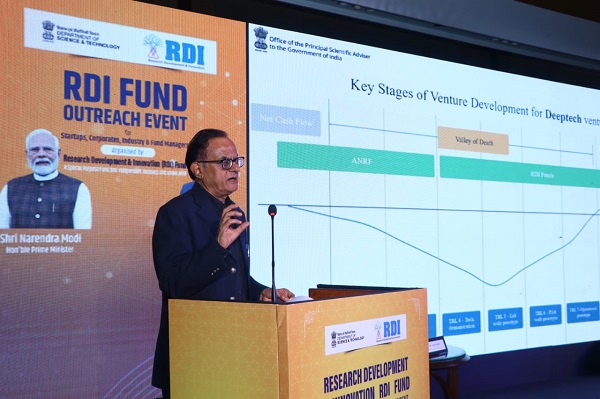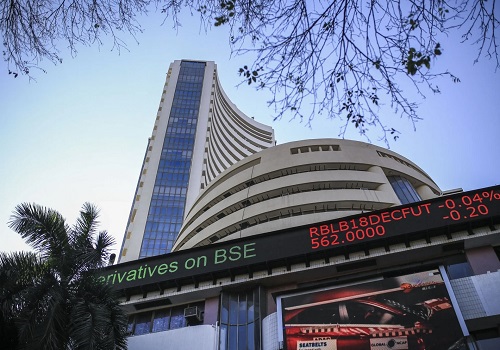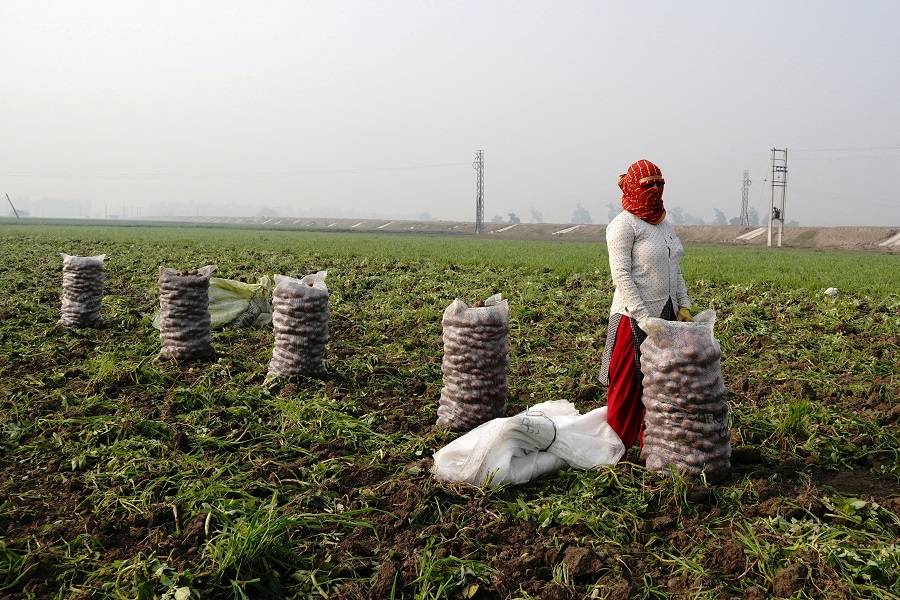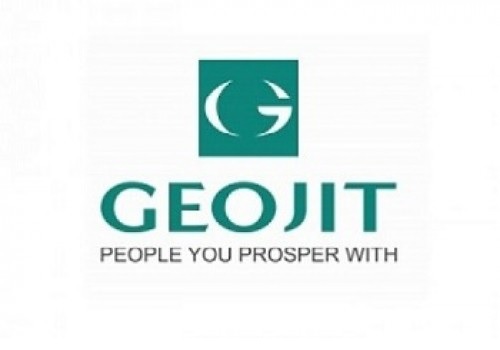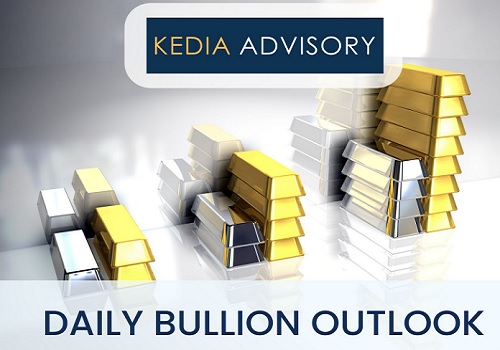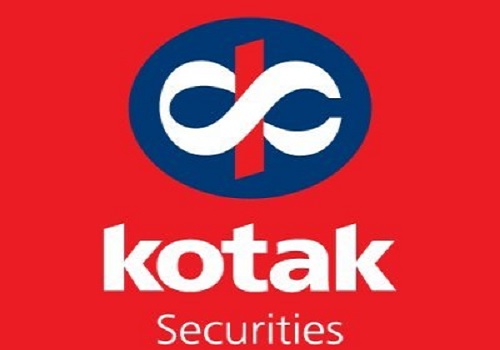Naturalgas trading range for the day is 314.5-351.7 - Kedia Advisory

Gold
Gold prices surged by 0.85% to settle at 88,384 as escalating global trade tensions fueled safe-haven demand. The primary catalyst for this rally was U.S. President Donald Trump’s announcement of a 25% tariff on imported cars and light trucks, set to take effect next week. These trade measures have intensified market uncertainty, prompting investors to seek refuge in gold. Traders are now closely watching Friday’s U.S. personal consumption expenditures (PCE) data, a key inflation gauge, to gain insight into the Federal Reserve’s potential rate-cut trajectory. Goldman Sachs raised its end-2025 price forecast to $3,300 per ounce, citing robust ETF inflows and continued central bank purchases. Large Asian central banks, particularly China’s, are expected to sustain aggressive gold acquisitions for the next three to six years, reinforcing gold’s long-term bullish outlook. China's gold imports via Hong Kong increased by 7.5% in February, reaching 14.851 metric tons, further reflecting strong institutional demand. However, despite this, Indian gold demand has weakened due to soaring prices, with dealers offering discounts of up to $41 per ounce—an eight-month high. India's gold imports are expected to plummet by 85% in February to a 20-year low. Technically, gold is experiencing short covering, with open interest declining by 34.26% to 3,836 contracts. Prices find support at 87,910, with further downside potential at 87,430. On the upside, resistance is seen at 88,745, and a breakout above this level could push prices toward 89,100.
Trading Ideas:
* Gold trading range for the day is 87430-89100.
* Gold prices climbed after U.S. President Donald Trump announced new tariffs on auto imports.
* Goldman Sachs raises end – 2025 gold price forecast to $3,300/OZ
* China's total gold imports via Hong Kong in February rose 7.5% from January
Silver
Silver prices surged by 1.84% to settle at 101,313 as the dollar index weakened to 104.3, driven by investor concerns over U.S. trade policies and mixed economic data. The primary catalyst for this rally was the Trump administration’s announcement of a 25% tariff on all non-U.S.-made cars, set to take effect on April 2. Additional threats of harsher tariffs on the EU and Canada added to global economic uncertainty, fueling safe-haven demand for silver. Investors also reacted to key U.S. economic data, including a slight upward revision in Q4 GDP to 2.4% and mixed signals from durable goods orders and consumer confidence. Market participants are now closely monitoring the upcoming PCE report for further insight into the Federal Reserve's rate-cut trajectory. Silver’s supply and demand dynamics remain bullish, with the market expected to record a significant deficit for the fifth consecutive year in 2025. Industrial silver demand is projected to reach a record high, surpassing 700 million ounces, driven by ongoing structural gains in green energy applications. Technically, the market is witnessing fresh buying, with open interest rising by 12.93% to 22,404 contracts. Silver has strong support at 100,015, with further downside potential to 98,715. On the upside, resistance is seen at 102,080, and a breakout above this level could push prices toward 102,845.
Trading Ideas:
* Silver trading range for the day is 98715-102845.
* Silver gained as dollar fell as investors weighed the impact of Trump’s new auto tariffs and digest economic data.
* The escalating trade war sparked fears of slower US economic growth and renewed inflation pressures.
* GDP growth for Q4 was revised slightly higher to 2.4% and core PCE prices also rose slightly less in Q4.
Crude Oil
Crude oil prices edged up by 0.07% to settle at 5,995 as market participants weighed the impact of new U.S. auto tariffs on global growth and fuel demand. President Donald Trump's announcement of a 25% tariff on all auto imports heightened transatlantic trade tensions, fueling concerns about economic slowdown and its effect on oil consumption. However, bullish factors also played a role, including a significant drop in U.S. crude inventories, indicating strong domestic demand. The latest data from the American Petroleum Institute showed a 4.6 million-barrel decline in U.S. crude stocks last week, with the official EIA report confirming a larger-than-expected draw of 3.341 million barrels. Despite this, global supply trends suggest potential headwinds. According to the International Energy Agency (IEA), oil supply could exceed demand by approximately 600,000 barrels per day in 2025, with the surplus potentially growing if OPEC+ continues unwinding production cuts. The agency also revised down its 2025 oil demand growth forecast by 70,000 bpd, citing weaker-than-expected consumption in late 2024 and early 2025, particularly amid macroeconomic uncertainty. While demand remains primarily driven by Asia, notably China's petrochemical sector, broader economic pressures continue to weigh on the outlook. Technically, the market is experiencing short covering, with open interest declining by 4.78% to 5,556 contracts. Crude oil finds support at 5,954, with further downside potential to 5,912. On the upside, resistance is seen at 6,025, and a break above this level could push prices toward 6,054.
Trading Ideas:
* Crudeoil trading range for the day is 5912-6054.
* Crude oil settled flat as the announcement of auto tariffs by U.S. President stoked worries about global growth.
* Trump ratcheted up transatlantic trade tensions by announcing a new 25-percent tariff on all auto imports.
* Crude oil inventories in the US fell by 3.341 million barrels - EIA
Natural Gas
Natural gas prices rose by 1.2% to settle at 337.9 as Freeport LNG’s Texas export plant resumed operations after a lightning strike caused a temporary shutdown earlier in the week. This restart is expected to boost gas flows to LNG export facilities, which have already averaged 15.7 bcfd in March, slightly higher than the record 15.6 bcfd in February. Further support for prices comes from the addition of new units at Venture Global’s Plaquemines LNG plant in Louisiana, increasing overall LNG export capacity. However, weather forecasts indicate above-normal temperatures across the Lower 48 states through April 9, which could reduce heating demand and allow utilities to inject more gas into storage. U.S. gas output has been rising, reaching 106.0 bcfd in March, surpassing February’s record of 105.1 bcfd. Additionally, U.S. utilities added 37 billion cubic feet (bcf) of gas to storage for the week ending March 21, significantly higher than market expectations of a 25 bcf increase. Despite this, storage levels remain 24.2% lower than last year and 6.5% below the five-year average, keeping market sentiment supported. Technically, the market is witnessing fresh buying, with open interest increasing by 17.43% to 10,131 contracts. Natural gas has support at 326.2, with further downside potential to 314.5. Resistance is seen at 344.8, and a breakout above could push prices toward 351.7.
Trading Ideas:
* Naturalgas trading range for the day is 314.5-351.7.
* Natural gas climbed as Freeport LNG’s Texas export plant resumed operations.
* Meteorologists predict above-normal temperatures across the Lower 48 states through April 9, likely reducing demand.
* Average gas output in the Lower 48 has climbed to 106.0 bcfd so far in March, surpassing February’s record 105.1 bcfd.
Copper
Copper prices declined by 0.92% to settle at 901.6 as market sentiment weakened following U.S. President Donald Trump's announcement of 25% tariffs on auto imports. These tariffs raise concerns over reduced metals demand, particularly for copper, a key material in the automotive sector. Investors have been closely monitoring the possibility of additional tariffs on copper imports, leading to price volatility, particularly on the U.S. Comex exchange. Citi Research now forecasts a 25% tariff on U.S. copper imports in Q2 2025 and has lowered its three-month price outlook to $9,500 per ton from $10,000. The growing price disparity between the London Metal Exchange (LME) and Comex is encouraging increased copper shipments to the U.S. in anticipation of the tariffs. Supply-side factors have also influenced price trends. LME copper inventories fell by 1,475 tons, with the largest drawdown at Port Klang warehouses. Meanwhile, Glencore declared force majeure on copper shipments from its Altonorte smelter in Chile, disrupting supply. Chile, the world's largest copper producer, reported a 2.1% year-on-year drop in copper output for January to 426,889 metric tons. However, China's refined copper production increased by 3.7% year-on-year to 2.3 million metric tons, reducing its reliance on imports, which fell by 7.2% in early 2025. Technically, copper is experiencing long liquidation, with open interest dropping by 3.43% to 8,302 contracts. The metal is finding support at 894.9, with a potential decline to 888.3 if breached. On the upside, resistance is seen at 911.2, and a breakout above could push prices toward 920.9.
Trading Ideas:
* Copper trading range for the day is 888.3-920.9.
* Copper prices eased after U.S. President Trump announced 25% tariffs on auto imports.
* LME continues to see copper prices trading at a record discount compared to futures contracts on New York’s Comex.
* LME inventory data showed that copper stocks fell by 1,475 tons, or 0.68%, to 215,275 tons.
Zinc
Zinc prices fell by 1.64% to settle at 272.7 as the global zinc market deficit narrowed to 10,000 metric tons in January from 41,100 tons in December. However, the downside was limited by persistent supply concerns and declining inventories. Zinc inventories in warehouses monitored by the Shanghai Futures Exchange dropped by 6.9% from last Friday, indicating tightening supply. Meanwhile, China's zinc production increased by 1.8% year-on-year in January and February to 1.13 million metric tons, signaling a willingness among Chinese smelters to ramp up output. Supply disruptions also played a key role in supporting zinc prices. Nyrstar announced a 25% production cut at its Hobart zinc operations in Australia starting in April, citing worsening conditions in raw material markets and increased costs. The facility, with a capacity of 260,000 metric tons per year, is a major producer, and its reduction will impact global supply. Additionally, the Red Dog Mine in Alaska, which accounts for 10% of global zinc output, is set to slow production in 2025 as ore reserves deplete. Looking at production trends, China's refined zinc output dropped by 8% month-on-month in February and over 4% year-on-year. Technically, the market saw fresh selling as open interest rose by 4.02% to 2,202 contracts while prices declined by 4.55 rupees. Zinc is finding support at 271, with a further test at 269.1 if breached, while resistance is seen at 276.3, with a move above potentially leading to 279.7.
Trading Ideas:
* Zinc trading range for the day is 269.1-279.7.
* Zinc dropped as global zinc market deficit fell to 10,000 metric tons in January.
* China’s zinc production in January and February rose 1.8% from the prior year to around 1.13 million metric tons.
* Nyrstar announced 25% production cuts at its Hobart zinc operations in Australia from April.
Aluminium
Aluminium prices declined by 0.75% to settle at 251.2 as improved raw material availability eased supply constraints. Major alumina producers in Guinea, Australia, and China ramped up production capacity, bringing alumina prices to near one-year lows and enhancing smelter processing rates. However, the supply of finished aluminium is expected to slow, with global primary aluminium output in February falling by 0.9% year-on-year to 5.645 million tonnes, according to the International Aluminium Institute (IAI). China produced a record 44 million tonnes of aluminium in 2024, but further growth will be restricted due to Beijing’s 45 million-tonne production cap aimed at controlling supply and reducing carbon emissions. Additionally, China's aluminium exports remained muted after the government removed tax rebates on overseas sales, encouraging domestic consumption and supporting foreign benchmark prices. In February 2025, China’s aluminium production increased by 0.4% year-on-year but dropped by 95,000 metric tonnes month-on-month, reflecting seasonal adjustments and project realignments. JP Morgan forecasts a severe tightening in the global aluminium market, with a projected deficit exceeding 600,000 metric tonnes by 2025 due to a slowdown in supply growth, particularly in China. Technically, the market saw fresh selling as open interest surged by 6.52% to 3,478 contracts, while prices fell by 1.9 rupees. Aluminium is currently supported at 249.1, with a drop below that potentially testing 246.9. On the upside, resistance is seen at 254.2, with a breakout possibly pushing prices towards 257.1.
Trading Ideas:
* Aluminium trading range for the day is 246.9-257.1.
* Aluminium dropped amid the improved availability for raw materials.
* Major alumina producers in Guinea, Australia, and China added new capacity to recover from series of disruptions last year.
* Global primary aluminium output in February fell 0.9% year on year to 5.645 million tonnes
Cottoncandy
Cottoncandy prices saw a marginal increase of 0.04% to settle at 53,900, driven by a significant rise in supply and restrained mill buying. Mills are well-stocked and are not in immediate need of purchases, limiting demand. The Cotton Association of India (CAI) revised its 2024-25 crop estimate downward by 2% to 295.30 lakh bales from its earlier projection of 301.75 lakh bales due to lower-than-expected output in central India. A nearly 10% reduction in cultivation area is expected to bring production down from last season’s 327.45 lakh bales. CAI projects cotton imports to double in the 2024-25 season, reaching 32 lakh bales compared to last season’s 15.20 lakh bales, with 22 lakh bales already imported by February-end. Meanwhile, domestic consumption remains steady at 315 lakh bales, while exports are expected to decline by 40% to 17 lakh bales. Closing stocks are projected to be lower at 23.49 lakh bales, compared to 30.19 lakh bales last year. On the global front, Brazil’s cotton production is set to rise by 1.6%, and the cotton planting area has expanded by 4.8%, signaling strong supply potential. Technically, the market experienced short covering with no change in open interest, remaining at 211 contracts. Prices saw a minor gain of 20 rupees. Immediate support is seen at 53,840, with a further downside potential to 53,770, while resistance is at 53,990, and a breakout above could push prices to 54,070.
Trading Ideas:
* Cottoncandy trading range for the day is 53770-54070.
* Cotton settled flat due to a substantial increase in supply and limited mill buying.
* Mills are well-stocked and are not facing immediate purchasing requirements.
* CAI has further reduced its 2024-25 crop estimate by 2 per cent to 295.30 lakh bales
* In Rajkot, a major spot market, the price ended at 25453.45 Rupees dropped by -0.51 percent.
Turmeric
Turmeric prices rose by 1.05% to settle at 13,280 due to lower-than-expected arrivals, which restricted supplies and triggered strong buying interest. Positive export trends further supported the price increase, with shipments reaching a four-year high, surpassing the 2020 export volume of 1.75 lakh tonnes. Despite an increase in the turmeric cultivation area to 3.30 lakh hectares, production is not expected to rise proportionally due to untimely rains impacting yields. The Nanded region, in particular, has been affected, with expectations of a 10-15% decline in productivity due to small rhizomes and some crop rots. Turmeric exports from April to December 2024 surged by 13%, reaching 136,921.04 tonnes compared to 121,170.97 tonnes in the same period of 2023. December 2024 exports stood at 15,319.82 tonnes, marking a 20.43% increase from November 2024 and a 46.94% rise from December 2023. Meanwhile, imports also saw a sharp rise of 84.35% during April-December 2024, reaching 19,644.14 tonnes. However, December imports dropped by 44.66% compared to November and 44.69% year-over-year, indicating reduced dependence on foreign turmeric supply. In the Nizamabad spot market, turmeric prices gained 0.94%, closing at 13,549.4 rupees. Technically, turmeric is experiencing short covering, as open interest declined by 5.62% to settle at 6,805 contracts while prices increased by 138 rupees. The immediate support level is at 13,044, with a potential test of 12,806 on the downside. Resistance is now observed at 13,500, with a possible breakout pushing prices towards 13,718.
Trading Ideas:
* Turmeric trading range for the day is 12806-13718.
* Turmeric gained as lower-than-expected arrivals restricted supplies, leading to strong buying interest.
* Meanwhile, exports continued to pick up in the second half of 2024, with shipments reaching a four-year high.
* New crop yields are expected to be 10-15% lower this year, with the Nanded region particularly affected by small rhizomes and some crop rots.
* In Nizamabad, a major spot market, the price ended at 13549.4 Rupees gained by 0.94 percent.
Jeera
Jeera prices saw a slight increase of 0.13%, closing at 22,585 as domestic demand and export activity, particularly from Gulf countries, provided support. Supply constraints also played a role, with limited arrivals from Rajasthan and a delayed new crop in Gujarat due to unfavorable weather conditions. Sowing in major producing states like Gujarat and Rajasthan began a month late, tightening near-term supplies. However, the upside remained limited as current demand is being met through existing stockpiles. India’s cumin production for 2023-24 is estimated at 8.6 lakh tonnes from an area of 11.87 lakh hectares, significantly higher than the previous year’s 5.77 lakh tonnes from 9.37 lakh hectares. The affordability of Indian cumin on the global market is expected to attract strong export demand, particularly from China, as Indian cumin is currently priced at $3,050 per tonne, about $200-$250 cheaper than Chinese cumin. Jeera exports surged by 70.72% between April and December 2024, reaching 165,084.40 tonnes compared to 96,701.43 tonnes in the same period last year. December exports were 18,078.19 tonnes, reflecting a 56.45% rise from November and a 47.77% increase from December 2023. Technically, jeera is witnessing short covering, with open interest falling by 5.67% to settle at 2,847 contracts. Immediate support is at 22,440, with further downside potential to 22,280. On the upside, resistance is seen at 22,730, and a breakout above this level could push prices to 22,860.
Trading Ideas:
* Jeera trading range for the day is 22280-22860.
* Jeera gains amid price support from domestic demand, as well as export activity.
* Only 3-4 lakh bags are expected to be traded by the end of the season, leaving a carry-forward stock of about 16 lakh bags.
* However downside seen limited amid price support from domestic demand, as well as export activity from Gulf countries.
* In Unjha, a major spot market, the price ended at 21991.85 Rupees dropped by -0.01 percent.
Views express by all participants are for information & academic purpose only. Kindly read disclaimer before referring below views





